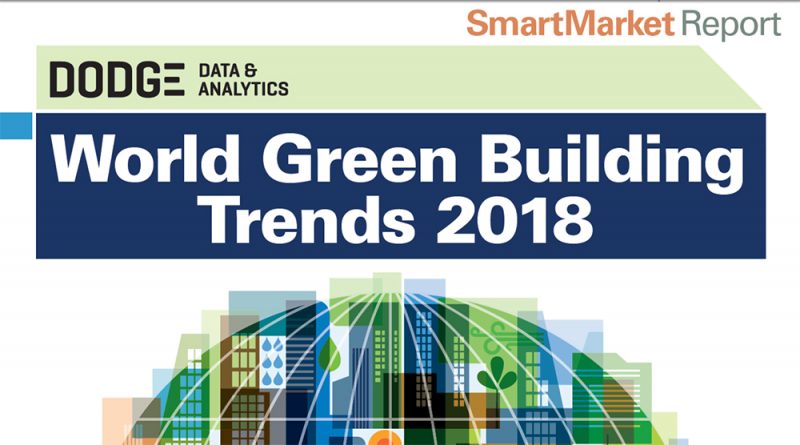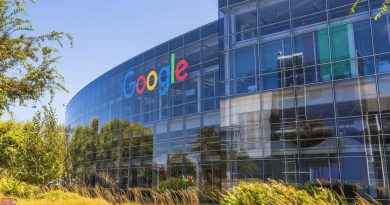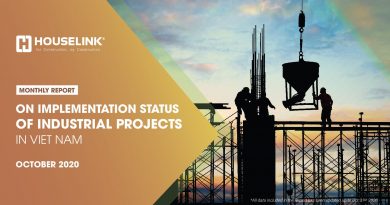World Green Building Trends 2018 – SmartMarket Report
The international market for green construction projects has grown significantly in the last 10 years and demand for green building activity is poised to grow in the next three years, according to a new report and industry survey published today by Dodge Data & Analytics. The World Green Building Trends 2018 SmartMarket Report indicates an increase in the percentage of industry respondents who expect to do the majority (more than 60%) of their projects green – jumping from 27% in 2018 to almost half (47%) by 2021.
Findings from the report illustrate the growing green building movement as organisations across the construction industry continue to shift towards more sustainable products and practices. Business benefits include 8% operating cost savings in the first year and increased building asset values of 7%, that are clearly influencing all those who do green building to deepen their engagement with green. In addition to the business benefits reported, social impacts are also increasing in their influence on the respondents as a major reason to build green. The top impact cited is improved occupant health and well-being.
The report, based on a global survey of more than 2,000 industry participants including architects, engineers, contractors, owners, specialists/consultants and investors from 86 countries, aims to analyse the level of green activity, the impact of green building practices on business operations, the triggers most likely to spur further green market growth and the challenges that may impede it. A total of 45 Green Building Councils (GBCs) across the world participated in the research. Nineteen countries in particular are featured in the report, spanning six continents and substantial growth in the percentage doing the majority of their projects green is expected in each.
There is an increased emphasis on social impacts in this study, including increased worker productivity, creating a sense of community and supporting the domestic economy. “The study, supported by our GBCs in five regions, demonstrates that green building is seen by industry as a key business benefit; and that around the world green building is considered to have an impact beyond significant environmental benefits, such as increased employee productivity and satisfaction,” says Terri Wills, CEO of the World Green Building Council.
Additional key findings from the report include:
- Globally, rating systems are being used to make better buildings. The research found certification systems are being used to create better performing buildings, yielding marketing and competitive advantages and, providing third party verification that buildings are green.
- While there has been strong growth in green building projects that are certified under a recognized green building rating system, there has been even stronger growth in green building projects that are not certified.
- Climate change remains a driver for green building, with 77% of the respondents listing lowering greenhouse gas emissions as an important reason for their organisation to be engaged in green building. In every region the most important environmental reason for green building was reduced energy consumption, which is closely linked to greenhouse gas emissions.
- Regulation is driving the take up of green building in South Asia, MENA and South East Asia, while client demand is a key driver among a number of countries with Established GBCs – Australia, North America and Western Europe. Environmental regulation is the strongest driver in the UK and Ireland.
- Overall, the barriers to green building have declined over time although cost is still a concern. The research showed that as part of the business case for green building, industry expects an increase in savings in operational costs within five years.
- The social benefits of green building have been growing as a driver, particularly occupant health and wellbeing, which reflects the importance of people in the built environment.
- Commercial construction remains the strongest sector for green building, however new high-rise residential building has also seen increases in green projects since 2015.
At a regional level the findings are:
- In Australia and New Zealand, the top sector for future green building is new commercial buildings with the top triggers being client and market demands.
- The most important triggers for new green building activity in Mainland China are market demand, healthier buildings, doing the right thing and branding/PR.
- In Europe, countries in the study expect to see a higher level of green activity by 2021, with expected growth in new commercial construction, existing building/retrofits and low rise residential.
- Indian respondents anticipate steep growth in their green activity in the next three years, driven by environmental regulations and the desire for healthier buildings. Lack of public awareness is cited as the top challenge to expanding green building efforts.
- Across the MENA region, respondents believe on average that a new green building will save 8% in operating costs over the first full year of operation
- The most frequently selected environmental reason for building green in the US, Canada and Mexico is to reduce energy consumption.
- Within three years South Africans anticipate that they will be doing a much higher level of green building activity, driven by the desire for lower operating costs and healthier buildings.
- The South American, Central America, Caribbean region all expect strong growth in levels of green activity. There is an emphasis on new green commercial and high-rise residential projects, with few green institutional projects expected.
- The top two influencing factors for future green building in Southeast Asia were environmental regulations and creating healthier buildings.
Detail:
Published 13 November 2018 by Dodge Data & Analytics
World Green Building Council participated as a premier research partner in the study produced by Dodge Data & Analytics in partnership with United Technologies, with major support by the American Institute of Architects (AIA) and Autodesk, additional support from the U.S. Green Building Council (USGBC).
Source: worldgbc.org







